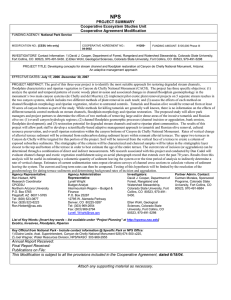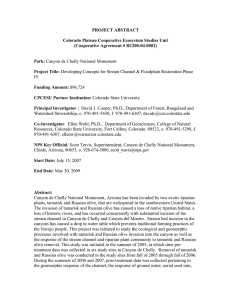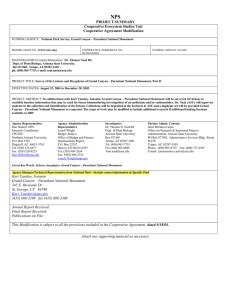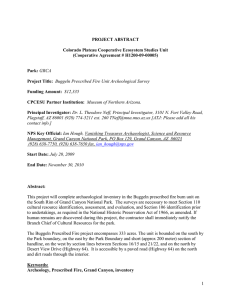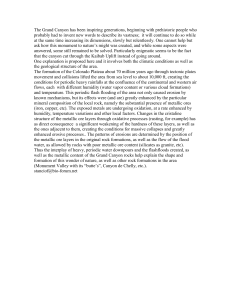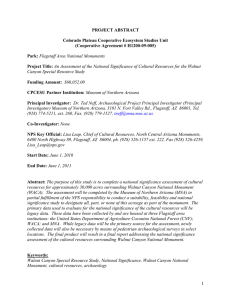CSU-103
advertisement
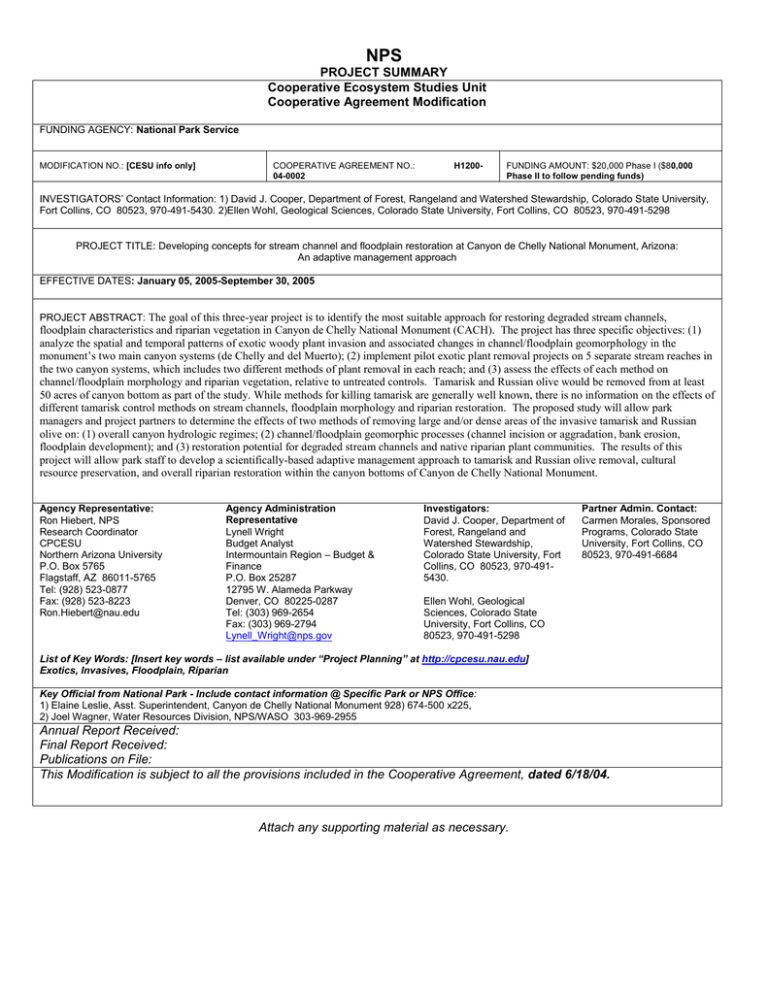
NPS PROJECT SUMMARY Cooperative Ecosystem Studies Unit Cooperative Agreement Modification FUNDING AGENCY: National Park Service MODIFICATION NO.: [CESU info only] COOPERATIVE AGREEMENT NO.: 04-0002 H1200- FUNDING AMOUNT: $20,000 Phase I ($80,000 Phase II to follow pending funds) INVESTIGATORS’ Contact Information: 1) David J. Cooper, Department of Forest, Rangeland and Watershed Stewardship, Colorado State University, Fort Collins, CO 80523, 970-491-5430. 2)Ellen Wohl, Geological Sciences, Colorado State University, Fort Collins, CO 80523, 970-491-5298 PROJECT TITLE: Developing concepts for stream channel and floodplain restoration at Canyon de Chelly National Monument, Arizona: An adaptive management approach EFFECTIVE DATES: January 05, 2005-September 30, 2005 PROJECT ABSTRACT: The goal of this three-year project is to identify the most suitable approach for restoring degraded stream channels, floodplain characteristics and riparian vegetation in Canyon de Chelly National Monument (CACH). The project has three specific objectives: (1) analyze the spatial and temporal patterns of exotic woody plant invasion and associated changes in channel/floodplain geomorphology in the monument’s two main canyon systems (de Chelly and del Muerto); (2) implement pilot exotic plant removal projects on 5 separate stream reaches in the two canyon systems, which includes two different methods of plant removal in each reach; and (3) assess the effects of each method on channel/floodplain morphology and riparian vegetation, relative to untreated controls. Tamarisk and Russian olive would be removed from at least 50 acres of canyon bottom as part of the study. While methods for killing tamarisk are generally well known, there is no information on the effects of different tamarisk control methods on stream channels, floodplain morphology and riparian restoration. The proposed study will allow park managers and project partners to determine the effects of two methods of removing large and/or dense areas of the invasive tamarisk and Russian olive on: (1) overall canyon hydrologic regimes; (2) channel/floodplain geomorphic processes (channel incision or aggradation, bank erosion, floodplain development); and (3) restoration potential for degraded stream channels and native riparian plant communities. The results of this project will allow park staff to develop a scientifically-based adaptive management approach to tamarisk and Russian olive removal, cultural resource preservation, and overall riparian restoration within the canyon bottoms of Canyon de Chelly National Monument. Agency Representative: Ron Hiebert, NPS Research Coordinator CPCESU Northern Arizona University P.O. Box 5765 Flagstaff, AZ 86011-5765 Tel: (928) 523-0877 Fax: (928) 523-8223 Ron.Hiebert@nau.edu Agency Administration Representative Lynell Wright Budget Analyst Intermountain Region – Budget & Finance P.O. Box 25287 12795 W. Alameda Parkway Denver, CO 80225-0287 Tel: (303) 969-2654 Fax: (303) 969-2794 Lynell_Wright@nps.gov Investigators: David J. Cooper, Department of Forest, Rangeland and Watershed Stewardship, Colorado State University, Fort Collins, CO 80523, 970-4915430. Partner Admin. Contact: Carmen Morales, Sponsored Programs, Colorado State University, Fort Collins, CO 80523, 970-491-6684 Ellen Wohl, Geological Sciences, Colorado State University, Fort Collins, CO 80523, 970-491-5298 List of Key Words: [Insert key words – list available under “Project Planning” at http://cpcesu.nau.edu] Exotics, Invasives, Floodplain, Riparian Key Official from National Park - Include contact information @ Specific Park or NPS Office: 1) Elaine Leslie, Asst. Superintendent, Canyon de Chelly National Monument 928) 674-500 x225, 2) Joel Wagner, Water Resources Division, NPS/WASO 303-969-2955 Annual Report Received: Final Report Received: Publications on File: This Modification is subject to all the provisions included in the Cooperative Agreement, dated 6/18/04. Attach any supporting material as necessary.
